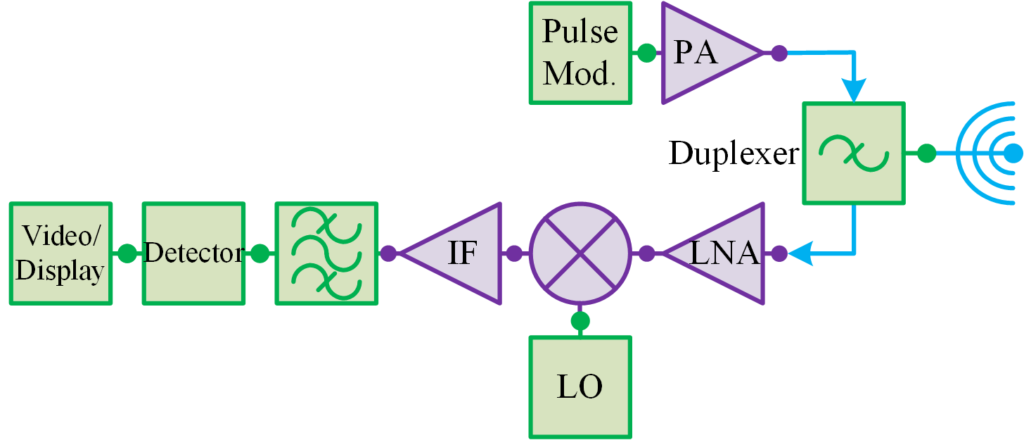A pulsed radar is a sensing system that uses a high power pulsed signal reflected off of objects to determine their distance from the radar antenna. The basic operation of a pulse radar is that a pulse modulator generates a short pulsed which is then amplified. The amplified pulse then passes through a duplexer or switching circuit to the pulse radar antenna. The pulse then travels through the air until it strikes an object capable of reflecting RF energy. Some of the resulting reflections off of a reflective object then interact with the radar antenna, generating and electrical signal. This signal is conducted to the receiver portion of the pulsed radar via the duplexer or switch, whose orientation was toggled immediately after the transmitted pulse passed through the duplexer/switch. The received signal is amplified with a low-noise-amplifier, as radar receive signals tend to be very weak. The amplified RF signal is then often mixed to an intermediate frequency (IF) signal that is then sent to a detector which gauges the time difference between when the original pulse was transmitted and the arrival of the receive signal. The time difference between transmission and reception determines the time-of-flight of the pulse, and hence how far and object is away from the radar.
There are several factors which determine the maximum and minimum range of a pulsed radar, as well as the range resolution of pulsed radar. The width of the pulse determines the minimum range as well as the range resolution of the pulsed radar, as a longer pulse requires a greater amount of time before the duplexer/switch orientation can be changed and the receiver is able to pick up a radar reflection. The pulse repetition frequency (PRF) of the radar, pulse transmit power, antenna efficiency, and the receiver sensitivity all can be limiting factors in the maximum range of a radar. A shorter PRF reduces the maximum range of a radar, but may provide greater insight into a target’s behavior. The transmit power, antenna efficiency, and receiver sensitivity limit the maximum range of a radar as the reflected signal must meet a certain minimum power level or the receiver won’t be able to adequately recover the signal for detection.
Range resolution is a desirable trait in pulsed radar, as better resolution allows for differentiation of multiple targets in “near” vicinity of each other, where otherwise lower range resolution would make the targets appear as a single target. A pulsed radar may also be used to determine a target’s velocity using the doppler effect and adjusting the radar’s PRF. However, adjusting the PRF impacts the maximum range, leading to a trade-off between range and velocity ambiguity. There are also more advanced pulse radar techniques that provide enhanced radar performance, such as pulse compression and pulse modulation. These technologies trade radar circuit complexity, cost, and size for better radar performance.

A high-level block diagram of a simple pulsed radar




 Pasternack Blog
Pasternack Blog
